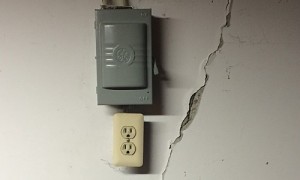 From the air we breathe to the things we eat, it seems like a new report comes out every week warning us of the dangers that surround us. Unfortunately your house may have substances that could be harmful to your health.
From the air we breathe to the things we eat, it seems like a new report comes out every week warning us of the dangers that surround us. Unfortunately your house may have substances that could be harmful to your health.
While generally a problem in older homes, the presence of certain substances in a residence may require disclosure. For example, asbestos was commonly used not only in insulation for a time but also in siding, shingles, some floor tiles and pipes and some textured paints.
While the use of asbestos has been generally discontinued since the 1970s, some remains in homes constructed prior to that time. When selling a home, the owners should be aware of any such hazards and ensure they properly disclose them to prospective buyers, or else they may be liable for any problems caused by these hazards after purchase. If it comes out during the negotiation process, it may sink a promising deal if buyers come to believe they cannot trust the home sellers.
I am currently in the process of buying my first home and when our inspector checked out our attic he picked up a big handful of what looked like kitty litter. He explained it was called vermiculite and that it could contain asbestos. Luckily we were able to work with the seller to get it removed safely but it is certainly something to be cautious of if you plan on buying an older home.
Asbestos and Lead
Asbestos should only be removed by a professional and only if necessary because the health risk increases if it is loose or crumbling. Removal may be required in some cases and optional in others.
Lead was commonly used in paints up to almost 1980, and in pipes even more recently. Like asbestos, lead can enter the body by breathing if it is loose in the form of dust. Chipped or cracking paint can be particularly hazardous, especially to children. Also like asbestos, homeowners are required to disclose the presence of any lead-based paint hazards in a home when selling it. Professionals are also required to remove it if that becomes necessary.
Mold
Mold can be a major problem in a home, leading to respiratory difficulties and allergies. Mold that grows undetected over a longer period of time can cause more serious problems. Unlike many other problems, mold can often be removed using everyday household cleaning supplies. Unfortunately, it may become too thoroughly embedded in porous carpets or other objects. In a worst case, it can get into the walls or ceilings and require professional help or a major project to remove it.
Radon
According to cancer.org, Radon is a colorless, odorless, radioactive gas. Radon is a problem in some homes, particularly in the northern U.S. While a test for radon is not necessarily required by law, the results of any test the home seller chooses to make must be disclosed. The source notes that some radon problems are complex and expensive to deal with but others are relatively easy and cheap to solve.
Educating yourself on what toxins may be lurking around your home is very important. For more homeowner resources click here.
Images via wallsave.com and ipcblog.org







[…] According to cancer.org, Radon is a colorless, odorless, radioactive gas. Radon is a problem in some homes, particularly in the northern U.S. While a test for radon is not necessarily required by law, the results of any test the home seller chooses to make must be disclosed. The source notes that some radon problems are complex and expensive to deal with but others are relatively easy and cheap to …read more […]
[…] According to cancer.org, Radon is a colorless, odorless, radioactive gas. Radon is a problem in some homes, particularly in the northern U.S. While a test for radon is not necessarily required by law, the results of any test the home seller chooses to make must be disclosed. The source notes that some radon problems are complex and expensive to deal with but others are relatively easy and cheap …read more […]
[…] Toxic Substances Found in Houses […]